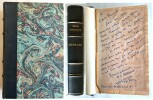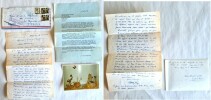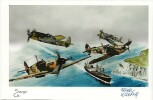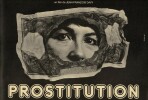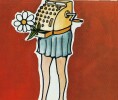9997 books for « francois jean francoi... »Edit
-
Type
Any type (1)
Book (10107)
Disk (4)
Engraving (4)
Magazine (41)
Manuscript (1)
Maps (12)
Music sheets (172)
New book (1)
Old papers (1)
Photographs (6)
-
Latest
Last 24h (6)
Last 3 days (6)
Last month (321)
Last week (14)
-
Language
Dutch (1)
French (10339)
Greek (2)
Italian (1)
Latin (1)
Russian (4)
Spanish (1)
Swedish (1)
-
Century
16th (4)
17th (32)
18th (390)
19th (514)
20th (4051)
21st (1649)
-
Countries
Belgium (375)
Brazil (3)
Canada (81)
China (1)
Côte d'Ivoire (11)
Denmark (22)
France (9156)
Germany (25)
Greece (2)
Italy (6)
Switzerland (664)
United States of America (4)
-
Syndicate
ALAC (69)
CLAM (17)
CLAQ (17)
CNE (11)
ILAB (4220)
NVVA (66)
SLACES (66)
SLAM (4003)
SNCAO (22)
Topics
- Alsace (56)
- Ancien régime (28)
- Aquitaine (57)
- Archaeology (73)
- Architecture (67)
- Army (27)
- Autographs (43)
- Barber (33)
- Bazin jean-françois (42)
- Biography (127)
- Blade jean françois (35)
- Bory jean-francois (38)
- Brittany (72)
- Burgundy (33)
- Catholicism (46)
- Chiappe jean-françois (44)
- Children’s books (142)
- Christianity (51)
- Christmas (76)
- Cinema (64)
- Coatmeur jean-françois (96)
- Comic strip (133)
- Computer science (32)
- Cooking (87)
- Culinary art (30)
- Dedication (58)
- Detective novels (38)
- Dictionaries (31)
- Drawings (63)
- Early printed books (78)
- Economics (88)
- Education (65)
- Education - morals (29)
- Egypt (48)
- Essays (33)
- Ethic (27)
- Ethnology (32)
- Fine arts (131)
- First edition (272)
- Genealogy (37)
- Geography (72)
- Helvética (103)
- Henault (46)
- History (541)
- Humour anecdotes (60)
- Illustrated books (32)
- Industrial arts & crafts - fine arts (55)
- Journalism (33)
- Kahn jean-françois (90)
- Law (120)
- Literature (951)
- Lorrain (34)
- Lyotard jean-françois (32)
- Magazine (58)
- Marmontel (100)
- Mauriac françois (67)
- Medicine (96)
- Memories (36)
- Menard alias colin de lafferierre (30)
- Middle ages (35)
- Music (34)
- Navy (46)
- Newspapers press (82)
- Painting (44)
- Paris (89)
- Philosophy (215)
- Photography (98)
- Poetry (157)
- Policy (200)
- Poujoulat (38)
- Psychoanalysis (27)
- Psychology (77)
- Regionalism (112)
- Regnard (87)
- Regnard jean-françois (47)
- Religions (130)
- Reliure (35)
- Revel jean-françois (179)
- Review (251)
- Reviews (137)
- Revolution 1789 (44)
- Sciences (55)
- Sciences & technique (29)
- Scores (157)
- Six jean françois (100)
- Social sciences (29)
- Sociology (54)
- Songs (172)
- Sports (39)
- Switzerland (114)
- Tales (37)
- Theatre (112)
- Theology (57)
- Travel (67)
- Various (76)
- War (89)
- Wine (43)
- Youth (51)
Pommier Francois - Jean Francois de Sauverzac
Reference : RO20275645
(1996)
ISBN : 270072190X
La psychanalyse a l'epreuve du sida
AUBIER. 1996. In-8. Broché. Bon état, Couv. convenable, Dos satisfaisant, Intérieur frais. 154 PAGES. . . . Classification Dewey : 610-Sciences médicales. Médecine
Classification Dewey : 610-Sciences médicales. Médecine
SENS DU PLACEMENT -LE- SEGREGATION RESIDENTIELLE ET SEGREGATION SCOLAIRE
RAISONS D'AGIR/LIBER
LIVRE A L’ETAT DE NEUF. EXPEDIE SOUS 3 JOURS OUVRES. NUMERO DE SUIVI COMMUNIQUE AVANT ENVOI, EMBALLAGE RENFORCE. EAN:9782912107435
"Paysage et architecture, essai de définition des""normes esthétiques"" applicables au milieu rural. Cahier d'urbanisme, N° 40-41. Collection : Chantiers dans le monde."
Bruxelles, Editions Art et Technique, 1965. 16 x 21, 68 pp., nombreuses figures et croquis, 2 illustrations, 13 figures, broché, très bon état (cachet d'ex-propriétaire).
De Negroni François - Jean-François Derousseaux
Reference : RO80208974
(1987)
ISBN : 285565372X
Le compte de Mirobert se porte comme un charme - Voyage dans la noblesse française
Olivier Orban. 1987. In-8. Broché. Etat d'usage, Couv. défraîchie, Dos satisfaisant, Intérieur frais. 287 pages. quelques rousseurs sur les tranches.. . . . Classification Dewey : 840.091-XX ème siècle
Classification Dewey : 840.091-XX ème siècle
Tueurs de Flics. Roman. ( Avec superbe dédicace de Frédéric Fajardie à Jean-François Fogel ).
Editions Néo / Collection Le Miroir Obscur ( Suspense Insolite Mystere ) n° 76 de 1984. In-8 broché de 134 pages au format 21,5 x 13,5 cm. Couverture illustrée par Jean-Claude Claeys. Dos carré. Plats et intérieur frais. Superbe état général. Préface de Jean-François Fogel. Edition originale enrichie d'une superbe dédicace autographe, signée, de Frédéric Fajardie à l'écrivain au journaliste, essayiste et écrivain, Jean-François Fogel. Provenance idéale.
Vente exclusivement par correspondance. Le libraire ne reçoit, exceptionnellement que sur rendez-vous. Il est préférable de téléphoner avant tout déplacement.Forfait de port pour un livre 8,50 €, sauf si épaisseur supérieure à 3 cm ou valeur supérieure ou égale à 100 €, dans ce cas expédition obligatoire au tarif Colissimo en vigueur. A partir de 2 livres envoi en colissimo obligatoire. Port à la charge de l'acheteur pour le reste du monde.Les Chèques ne sont plus acceptés.Pour destinations extra-planétaire s'adresser à la NASA.Membre du Syndicat Lusitanien Amateurs Morues
Etat d'Urgence. ( Avec belle dédicace de Jean-François Vilar )
Editions Presses de la Renaissance 1985. In-8 broché de 274 pages au format 14 x 22,5 cm. Couverture photo. Dos carré. Plats et intérieur frais, malgré d'infimes frottis aux coins et bords des plats. Bel état général. Edition originale, ornée d'une très belle dédicace autographe, signée et datée de Jean-François Vilar. Celles-ci sont rares.
Vente exclusivement par correspondance. Le libraire ne reçoit, exceptionnellement que sur rendez-vous. Il est préférable de téléphoner avant tout déplacement.Forfait de port pour un livre 8,50 €, sauf si épaisseur supérieure à 3 cm ou valeur supérieure ou égale à 100 €, dans ce cas expédition obligatoire au tarif Colissimo en vigueur. A partir de 2 livres envoi en colissimo obligatoire. Port à la charge de l'acheteur pour le reste du monde.Les Chèques ne sont plus acceptés.Pour destinations extra-planétaire s'adresser à la NASA.Membre du Syndicat Lusitanien Amateurs Morues
Georges Ribemont-Dessaignes - Jacques Bens - Norge - Hélène Ranger - Jean-François Ozenda - Michel-Edmond Bertrand - Pierre Goujon - Claude Belleudy - Robert Rovini - James Ritchie.
Reference : 3786
(1968)
Neuf Poètes, Poèmes Neufs. Tirage unique numéroté à 200 exemplaires avec 5 lithographies originales numérotées et signées par Claude Belleudy, Jean-François Ozenda, James Ritchie, Hélène Ranger et Georges Ribemont-Dessaignes
Pierre Chavé / Vence 1968. In-8 en feuilles de 16 pages au format 19 x 26,8 cm. Couverture avec titre imprimé. Rencontres poétiques avec 9 poèmes inédits de Jacques Bens, Norge, Hélène Ranger, Jean-François Ozenda, Michel-Edmond Bertrand, Pierre Goujon, Claude Belleudy, Robert Rovini, Georges Ribemont-Dessaignes. Rarissime plaquette tirée à 200 exemplaires ( n° 81 ) accompagnés de 5 lithographies originales numérotés et signées de Claude Belleudy, Jean-François Ozenda, James Ritchie, Hélène Ranger et Georges Ribemont-Dessaignes. Plats un beu brunis avec petites rousseurs. Intérieur frais. Superbe état. Rare édition originale.
Vente exclusivement par correspondance. Le libraire ne reçoit, exceptionnellement que sur rendez-vous. Il est préférable de téléphoner avant tout déplacement.Forfait de port pour un livre 8,50 €, sauf si épaisseur supérieure à 3 cm ou valeur supérieure ou égale à 100 €, dans ce cas expédition obligatoire au tarif Colissimo en vigueur. A partir de 2 livres envoi en colissimo obligatoire. Port à la charge de l'acheteur pour le reste du monde.Les Chèques ne sont plus acceptés.Pour destinations extra-planétaire s'adresser à la NASA.Membre du Syndicat Lusitanien Amateurs Morues
( Photographie ) - Félix Tournachon dit Nadar - Jean-François Bory - Philippe Néagu - Jean-Jacques Poulet-Allamagny.
Reference : 3558
(1979)
Nadar tome 1 et 2 : Photographies - Dessins et Ecrits.
Editions Arthur Hubschmid 1979. Deux forts volumes in-8 reliure toile éditeur de 1300 pages au total ( pagination en continu ), au format 14 x 12 x 22 cm. Couvertures et dos rond avec titre. Complet des jaquettes illustrées ( photo et dessin ). Livres glissés sous carton gris de protection, abimé. Plats et intérieur frais, malgré une légère trace de mouillure en haut de la jaquette du tome 2. Le premier volume, préfacé par Jean-François Bory, recense plus de 600 photographies de Nadar choisies et commentées par Philippe Néagu et Jean-Jacques Poulet-Allamagny. le second volume recueille des centaines de dessins et textes de Nadar : Revue Comique à l'usage des gens sérieux - Môssieu Réac - Petits albums pour rire - Dessins - Panthéon Nadar - Ecrits - Droit au vol - Quand j'étais photographe. Choix, notes de préface de Jean-François Bory pour le second volume, qui forme le catalogue raisonné de l'ensemble de la production écrite et dessinée de Nadar. Edition originale. Rare ensemble des deux tomes en superbe état général.
Vente exclusivement par correspondance. Le libraire ne reçoit, exceptionnellement que sur rendez-vous. Il est préférable de téléphoner avant tout déplacement.Forfait de port pour un livre 8,50 €, sauf si épaisseur supérieure à 3 cm ou valeur supérieure ou égale à 100 €, dans ce cas expédition obligatoire au tarif Colissimo en vigueur. A partir de 2 livres envoi en colissimo obligatoire. Port à la charge de l'acheteur pour le reste du monde.Les Chèques ne sont plus acceptés.Pour destinations extra-planétaire s'adresser à la NASA.Membre du Syndicat Lusitanien Amateurs Morues
( Littérature Policière - Bibliographie ) - John-Dickson Carr - Patrick Quentin - Jean-François Naudon - François Guérif - Michel Lebrun - Maurice-Bernard Andrède.
Reference : 30971
(1987)
Les Amis du Crime, n° 2 : Dossier Patrick Quentin et fin de la bibliographie de John Dickson Carr.
Paris, Les Amis du Crime 1977. In-4 broché, agrafé, non paginé. Couverture avec titre imprimé. Texte de Jean-François Naudon, François Guérif, Michel Lebrun, Maurice-Bernard Andrède, etc. Publication entièrement consacré à Patrick Quentin et à la fin de la bibliographie de John Dickson Carr. Bel état de fraicheur. Rare édition originale, de ce fanzine, uniquement tirée de manière artisanale à 100 exemplaires.
Vente exclusivement par correspondance. Le libraire ne reçoit, exceptionnellement que sur rendez-vous. Il est préférable de téléphoner avant tout déplacement.Forfait de port pour un livre 8,50 €, sauf si épaisseur supérieure à 3 cm ou valeur supérieure ou égale à 100 €, dans ce cas expédition obligatoire au tarif Colissimo en vigueur. A partir de 2 livres envoi en colissimo obligatoire. Port à la charge de l'acheteur pour le reste du monde.Les Chèques ne sont plus acceptés.Pour destinations extra-planétaire s'adresser à la NASA.Membre du Syndicat Lusitanien Amateurs Morues
( Littérature adaptée au Cinéma - Bagne ) - Henri Charrière dit " Papillon " - Jean-Pierre Castelnau - Jean-François Revel.
Reference : 32093
(1969)
Papillon suivi de Papillon ou la littérature orale. ( Exemplaire unique avec dédicace pleine page et lettre manuscrite de Henri Charrière, ainsi que d'une lettre tapuscrite et un projet de couverture de livre par Guy de la Fregonnière, agent consulaire de France aux Bahamas ).
Editions Robert Laffont 1969. Fort in-8 relié de 516 pages au format 24 x 5 x 15,5 cm. Elégante reliure demi chagrin vert avec plats et pages de garde en papier marbré. Dos rond à 4 nerfs avec titre et filets doré. Couvertures non conservées. Plats et intérieur frais. Préface de Jean-Pierre Castelnau. Récit de Henri Charrière suivi de " Papillon ou la littérature orale " par Jean-François Revel. Un témoignage capital sur les bagnes. Edition originale. Exemplaire unique ayant appartenu Guy de la Fregonnière, agent consulaire de France aux Bahamas. Ce dernier ayant écrit une lettre tapuscrite à Henri Charrière, datée du 3 juillet 1969, lui demandant s'il se souvenait d'un bagnard nommé Henri de Boynes dit " Marquis ", dont il s'occupa bénévolement avec sa femme à Nassau dans le l'île de New Providence et qui lui proposa un livre ( mal écrit ) portant le titre " 34 ans d'enfer ". Henri Charrière lui répond par un lettre manuscrite, sous enveloppe affranchie, datée et signée " Caracas, 22-7-1969 " ainsi que par une dédicace pleine page à coller en page de garde. On trouve aussi un projet de couverture de livre réalisée par le Baron Guy de la Monnerie, avec texte et dédicace de Guy de la Fregonnière au verso.Je n'ai trouvé aucune information sur le soi-disant bagnard Henri de Boynes dit " Marquis ", ni sur un livre sur le bagne portant le titre " 34 ans d'enfer ". Henri Charrière fut jugé et condamné aux travaux forcés à perpétuité, au bagne en Guyane française, le 28 octobre 1931, pour le meurtre de Roland Legrand, meurtre qu'il a toujours nié. Parti de la citadelle de Saint-Martin-de-Ré le 29 septembre 1933 à bord du bateau "La Martinière" il débarque le 14 octobre avec le statut de " transporté " à Saint-Laurent-du-Maroni. Vont suivre treize années de bagne en Guyane pendant lesquels il tentera 2 évasions. La première aura lieu 43 jours après son arrivée au bagne, le 5 septembre 1934, pour un périple de trois mois : 2.500 km en mer, l'île de Trinidad, les Anglais, la Colombie et ses cachots sous-marins, les indiens Guajiros, les cavales de Baranquilla. Mais la Colombie rendra ses bagnards évadés à la France. Il passera deux ans dans une cage à fauves, dans les cellules de la réclusion de l'île Saint-Joseph. Plusieurs fois transféré, et après plusieurs tentatives, au bout de treize ans, il s'évade pour la seconde fois dans la nuit du 18 au 19 mars 1944 avec quatre autres compagnons. Après de nombreux déboires, un passage par la Guyane anglaise, la traversée de l'océan dans un canot d'abord, l'enfermement dans un bagne au Venezuela, il parviendra à Caracas toujours au Vénézuela en 1946. Au bout de toutes ces épreuves, de toutes ces souffrances, il trouvera la liberté. Il sera naturalisé Vénézuelien, et se mariera avec Rita Alcover et finira sa vie dans ce pays où devenu commerçant respectable, il exploitera à Caracas, avec son épouse, des hôtels, restaurants et discothèques.La prescription de sa peine arrivant en 1967, Papillon peut fouler le sol français. Il publie en 1969, ce livre à succès réputé autobiographique où il y raconte ses années de bagnard, en Guyane française, dans les années 1930 et 1940. Enorme succès, le livre s’est vendu à plusieurs millions d’exemplaires. C'est le succès du livre " L'Astragale " d'Albertine Sarrazin, un autre récit d'évasion, qui aurait encouragé l’auteur à écrire ses mémoires. Avec le recul, le livre est vu comme une biographie largement romancée. Plusieurs des faits présentés comme appartenant à la vie de Henri Charrière furent en réalité vécus par d'autres personnages, notamment : Clément Duval, Marius Jacob, René Belbenoît, Pierre Bougrat et Charles Brunier. À la décharge d'Henri Charrière, il semble que le premier jet de Papillon était une compilation d'aventures de différents bagnards. Robert Laffont, dans le but de rendre le récit plus vivant, aurait demandé à l'auteur de tout reprendre à la première personne du singulier. Il semblerait aussi que l'écrivain Max Gallo aurait été le coauteur caché de Papillon, car il fallait un professionnel du récit historique pour donner son souffle épique au roman. Même si Robert Laffont a affirmé, dans ses souvenirs en 1974, avoir la preuve que Henri Charrière était le seul auteur du livre de nombreux journalistes et essayistes évoquent le patient travail de Max Gallo sur ce livre. L'aspect autobiographique a été contesté par différentes investigations, notamment par celles du journaliste Georges Ménager dans son livre " Les Quatre Vérités de Papillon", par Gérard de Villiers dans son ouvrage " Papillon épinglé " ainsi que par le documentaliste Roger-Jean Ségalat envoyé par Robert Laffont sur les lieux du récit pour en contrôler la véracité. Le livre aura 2 adaptations au cinéma. La première en 1973, réalisée par Franklin J. Schaffner sur scénario de Dalton Trumbo et Lorenzo Semple Jr avec dans les rôles principaux Steve McQueen et Dustin Hoffman. La seconde date de 2017, réalisée par par Michael Noer sur scénario de Aaron Guzikowski, avec dans les rôles principaux Charlie Hunnam et Rami Malek.
Vente exclusivement par correspondance. Le libraire ne reçoit, exceptionnellement que sur rendez-vous. Il est préférable de téléphoner avant tout déplacement.Forfait de port pour un livre 8,50 €, sauf si épaisseur supérieure à 3 cm ou valeur supérieure ou égale à 100 €, dans ce cas expédition obligatoire au tarif Colissimo en vigueur. A partir de 2 livres envoi en colissimo obligatoire. Port à la charge de l'acheteur pour le reste du monde.Les Chèques ne sont plus acceptés.Pour destinations extra-planétaire s'adresser à la NASA.Membre du Syndicat Lusitanien Amateurs Morues
( Bob Morane ) - Henri Vernes - Serge Grispoux - Franck Leclercq - Jean-François Charles.
Reference : 28009
La Jeunesse de Bob Morane : Prologue. ( Tirage unique de luxe, à 100 exemplaires numérotés avec jaquette inédite et 2 ex-libris, dont un signé par Serge Grispoux et Franck Leclercq et l'autre par Jean-François Charles ).
Editions Ananké / Collection Bob Morane BM GF n° 311 de 2021. In-8 broché de 174 pages au format 23 x 14,5 cm. Couverture illustrée par Franck Leclercq. Aventure de Bob Morane écrite par Serge Grispoux, d'après les personnages créés par Henri Vernes. Tirage unique de luxe, à 100 exemplaires numérotés avec jaquette inédite et 2 ex-libris, dont un signé par Serge Grispoux et Franck Leclercq et l'autre par Jean-François Charles. Edition originale. Etat de neuf.
Vente exclusivement par correspondance. Le libraire ne reçoit, exceptionnellement que sur rendez-vous. Il est préférable de téléphoner avant tout déplacement.Forfait de port pour un livre 8,50 €, sauf si épaisseur supérieure à 3 cm ou valeur supérieure ou égale à 100 €, dans ce cas expédition obligatoire au tarif Colissimo en vigueur. A partir de 2 livres envoi en colissimo obligatoire. Port à la charge de l'acheteur pour le reste du monde.Les Chèques ne sont plus acceptés.Pour destinations extra-planétaire s'adresser à la NASA.Membre du Syndicat Lusitanien Amateurs Morues
Couleur sourire.
Mulhouse, Editions l'alsace, 1988; in-8 oblong, 116 pp., cartonnage de l'éditeur. Illustré par jean-françois mattauer - dédicacé à Mordicus.
Illustré par jean-françois mattauer - dédicacé à Mordicus.
( Prostitution - Dossiers de Presse Cinéma ) - Jean-François Davy - Guy Pinot
Reference : 27660
(1973)
Dossier de Presse. Prostitution, un Long-métrage de Jean-François Davy + Mission d'Information sur la Prostitution, Rapport de Guy Pinot, Premier Présisent de Cour d'Appel.
Editions Contrechamp, Félix Films 1976. In-8 broché à l'italienne de 26 pages au format 20,5 x 29,5 cm. Couverture avec photo. Contient la fiche technique, un dossier sur la prostitution, un entretien avec le metteur en scène, Jean-François Davy avec sa biographie, et une présentation des prostituées ayant accepter de parler. Belles illustrations en couleurs hors texte.Ce documentaire est composé de témoignages de prostituées, au travers d'une dizaine d'entretiens se rapportant plus spécialement à la biographie des prostituées interrogées, qui tentent de persuader de l'intérêt social de la prostitution, ainsi que des problèmes inhérents qu'elle engendre dans une société répressive....Etat superbe, proche du parfait, Rare édition originale.
Vente exclusivement par correspondance. Le libraire ne reçoit, exceptionnellement que sur rendez-vous. Il est préférable de téléphoner avant tout déplacement.Forfait de port pour un livre 8,50 €, sauf si épaisseur supérieure à 3 cm ou valeur supérieure ou égale à 100 €, dans ce cas expédition obligatoire au tarif Colissimo en vigueur. A partir de 2 livres envoi en colissimo obligatoire. Port à la charge de l'acheteur pour le reste du monde.Les Chèques ne sont plus acceptés.Pour destinations extra-planétaire s'adresser à la NASA.Membre du Syndicat Lusitanien Amateurs Morues
Couleur sourire.
Mulhouse, Editions l'alsace, 1988; in-8 oblong, 116 pp., cartonnage de l'éditeur. Illustré par jean-françois mattauer.
Illustré par jean-françois mattauer.
Couleur sourire.
Mulhouse, Editions l'alsace, 1988; in-8 oblong, 116 pp., cartonnage de l'éditeur. Illustré par jean-françois mattauer - dédicacé à Mordicus.
Illustré par jean-françois mattauer - dédicacé à Mordicus.
( Revue Actuel ) - Léon Mercadet - Jean-François Bizot - Michel-Antoine Burnier - Patrick Rambaud - Jean-Pierre Lentin - Robert Crumb.
Reference : 22632
Actuel par Actuel : Chronique d'un Journal et de ses Lecteurs, 1970-1975.
Editions Stock / Collection Dire n° 2 de 1977. In-8 broché de 286 pages au format 20 x 12 cm. Couverture illustrée par Robert Crumb et par une photographie des membres d'Actuel, prise par Pierre Fauchaux. Dos carré. Plats avec petits tassements et frottis aux coins. Petite tache en haut du 1er plat et de la tranche supérieure. Colonne de chiffres au verso du 4ème plat. Etude et analyse le publication " Actuel " et de ses membres. Textes de Léon Mercadet, Jean-François Bizot, Michel-Antoine Burnier, Patrick Rambaud, Jean-Pierre Lentin. Edition originale en assez bel état général.
Vente exclusivement par correspondance. Le libraire ne reçoit, exceptionnellement que sur rendez-vous. Il est préférable de téléphoner avant tout déplacement.Forfait de port pour un livre 8,50 €, sauf si épaisseur supérieure à 3 cm ou valeur supérieure ou égale à 100 €, dans ce cas expédition obligatoire au tarif Colissimo en vigueur. A partir de 2 livres envoi en colissimo obligatoire. Port à la charge de l'acheteur pour le reste du monde.Les Chèques ne sont plus acceptés.Pour destinations extra-planétaire s'adresser à la NASA.Membre du Syndicat Lusitanien Amateurs Morues
( Revue Ailleurs ) - Arden Quin - Jean Malrieu - Claude Pélieu - Arthur Rimbaud - Jean-François Bory - Collectif.
Reference : 12200
Revue Ailleurs n° 7 : Littérature - Arts Plastiques - Anticipation - Critique.
Revue Ailleurs n° 7 de 1965. In-8 broché oblong de 96 pages au format 24 x 13 cm. Belle couverture illustrée par Arden Quin. Dos carré, légèrement insolé, avec infimes frottis blancs. Plat et intérieur frais. Revue consacrée à la littérature, aux Arts Plastiques, à l'Anticipation et à la Critique. Textes et illustrations inédites en noir par Arden Quin, Jean Malrieu, Julien Blaine, Claude Pélieu, Rita Parr, Jean-François Bory, Arthur Rimbaud, Alberto Rody, Asis, Cahn, Bernard Kordon, etc. Impressions sur papiers de différentes couleurs. Rarissime édition originale.
Vente exclusivement par correspondance. Le libraire ne reçoit, exceptionnellement que sur rendez-vous. Il est préférable de téléphoner avant tout déplacement.Forfait de port pour un livre 8,50 €, sauf si épaisseur supérieure à 3 cm ou valeur supérieure ou égale à 100 €, dans ce cas expédition obligatoire au tarif Colissimo en vigueur. A partir de 2 livres envoi en colissimo obligatoire. Port à la charge de l'acheteur pour le reste du monde.Les Chèques ne sont plus acceptés.Pour destinations extra-planétaire s'adresser à la NASA.Membre du Syndicat Lusitanien Amateurs Morues
( Musique - Rock - Robert Allen Zimmerman, dit Bob Dylan ) - William Burroughs - Marc De Smedt - Benoît Feller - Philippe Paringaux - Michel Tisseau - Jean-Pierre Collard - Edouard Tiné - Daniel Odier - Williams Burroughs - Hervé Volkman - Jean-François Bizot - Pierre Hahn - Alan W.Watt - Lawrence Ferlinghetti - Allen Ginsberg - Hart Leroy Bibbs - Robert Lowell.
Reference : 14184
Bob Dylan et la Beat Generation, changer la vie.
Le Nouveau Planète / Planète plus n° 21 de 1971. In-8 broché carré de 146 pages au format 20 x 17,5 cm cm. Couverture illustrée en photos-montage. Dos carré. Plats et intérieur frais. Numéro spécial réalisé par Marc de Smedt, entiérement consacré à Robert Allen Zimmerman, dit Bob Dylan, et à la Beat Génération, avec une très importante iconographie, composée de photos, dessins et documents. Textes de Marc De Smedt, Benoît Feller, Philippe Paringaux, Michel Tisseau, Jean-Pierre Collard, Edouard Tiné, Daniel Odier, Williams Burroughs, Hervé Volkman, Jean-François Bizot, Pierre Hahn, Alan W.Watt. Entretien avec William Burroughs et anthologie de textes de la Beat Generation : Lawrence Ferlinghetti, Allen Ginsberg, Hart Leroy Bibbs, Robert Lowell. Edition originale en état superbe, proche du parfait.
Vente exclusivement par correspondance. Le libraire ne reçoit, exceptionnellement que sur rendez-vous. Il est préférable de téléphoner avant tout déplacement.Forfait de port pour un livre 8,50 €, sauf si épaisseur supérieure à 3 cm ou valeur supérieure ou égale à 100 €, dans ce cas expédition obligatoire au tarif Colissimo en vigueur. A partir de 2 livres envoi en colissimo obligatoire. Port à la charge de l'acheteur pour le reste du monde.Les Chèques ne sont plus acceptés.Pour destinations extra-planétaire s'adresser à la NASA.Membre du Syndicat Lusitanien Amateurs Morues
( Revue Ailleurs ) - Arden Quin - Jacques Abeille - Claude Pélieu - Isidore Ducasse dit Comte de Lautréamont - Frédérik Tristan - Rita Parr - Julian Blaine - Jean-François Bory - Collectif.
Reference : 30864
Revue Ailleurs n° 8 : Littérature - Arts Plastiques - Anticipation - Poésie complet de la bande-annonce " Lautréamont ".
Revue Ailleurs n° 8 de 1966. In-8 broché oblong de 96 pages au format 24 x 13 cm. Belle couverture illustrée d'un portrait imaginaire d'Isidore Ducasse par Antonio Asis réalisé en photogramme d'après la gravure de Mendes Magarinos. Dos carré, légèrement insolé. Plat et intérieur frais. Revue consacrée à la littérature, aux Arts Plastiques, à l'Anticipation, à la critique et à la Poésie. Complet de la rara bande-annonce " Lautréamont ". Textes et illustrations inédites en noir par Arden Quin, Jacques Abeille, Claude Pélieu, Isidore Ducasse dit Comte de Lautréamont, Frédérik Tristan, Rita Parr, Julian Blaine, Jean-François Bory, Antonio Asis, Mary Vieira, Claude Gautreau, etc. Impressions sur papiers de différentes couleurs. Rarissime édition originale en superbe état général.
Vente exclusivement par correspondance. Le libraire ne reçoit, exceptionnellement que sur rendez-vous. Il est préférable de téléphoner avant tout déplacement.Forfait de port pour un livre 8,50 €, sauf si épaisseur supérieure à 3 cm ou valeur supérieure ou égale à 100 €, dans ce cas expédition obligatoire au tarif Colissimo en vigueur. A partir de 2 livres envoi en colissimo obligatoire. Port à la charge de l'acheteur pour le reste du monde.Les Chèques ne sont plus acceptés.Pour destinations extra-planétaire s'adresser à la NASA.Membre du Syndicat Lusitanien Amateurs Morues
[COLLECTION AGIR ET CONNAITRE , RAPACE] - FRANCOIS TERRASSE (Michel et jean francois ) -
Reference : 201710281
Kama Sutra.
Editions Point Image-JVDH / Collection " L'Index " n° 1 de 2002. In-8 cartonnage éditeur non paginé au format 15,5 x 21,5 cm. Dos toilé rouge. Couverture illustrée. Préface par Arnaud de la Croix. Choix de textes extraits du " Kama Sutra " avec de magnifiques illustrations par Jean-François Charles. Tirage unique à 1000 exemplaires numérotés sur papier conquéror ( n° 953 ), signés par l'illustrateur. Edition originale en état proche du neuf. Epuisé.
Vente exclusivement par correspondance. Le libraire ne reçoit, exceptionnellement que sur rendez-vous. Il est préférable de téléphoner avant tout déplacement.Forfait de port pour un livre 8,50 €, sauf si épaisseur supérieure à 3 cm ou valeur supérieure ou égale à 100 €, dans ce cas expédition obligatoire au tarif Colissimo en vigueur. A partir de 2 livres envoi en colissimo obligatoire. Port à la charge de l'acheteur pour le reste du monde.Les Chèques ne sont plus acceptés.Pour destinations extra-planétaire s'adresser à la NASA.Membre du Syndicat Lusitanien Amateurs Morues
Quatre milliards de journaux - la presse de province.
Paris, Editions Alain Moreau, 1977; in-8, 484 pp., broché, couverture illustr avec sa jaquette. Très bon état - histoire de la presse de 1945 à nos jours.
Très bon état - histoire de la presse de 1945 à nos jours.
La croisière de l'astérion.
Paris, Fleurus editions gautier languereau - collection jean-francois, 1951; in-12, 126 pp., broché, couverture illustr (ptes usures). Illustrations de janloup - traduit de l'anglais par Yvonne Girault.
Illustrations de janloup - traduit de l'anglais par Yvonne Girault.
N.K. mène le jeu.
Paris, Fleurus editions gautier languereau collection jean francois, 1953; in-12, 122 pp., broché, couverture illustr. Illustrations de Pierre Joubert.
Illustrations de Pierre Joubert.
Enigmes en héritage.
Paris, Fleurus - editons gautier-languereau, 1953; in-12, 124 pp., broché, couverture illustr. Illustrations de alain d'orange.
Illustrations de alain d'orange.
 Write to the booksellers
Write to the booksellers













